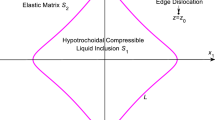The problem of an interface tunnel crack and an interface tunnel rigid inclusion perfectly coupled with a piecewise homogeneous anisotropic space is reduced to a system of six singular integral equations. To solve this system, we proposed an efficient numerical-analytic method. The mutual influence of the crack and the inclusion is investigated. In particular, we establish the dependences of the generalized stress intensity factors at the tips of the crack and the inclusion on the relative distance between them.
Similar content being viewed by others
References
R. V. Duduchava, Integral Convolution Equations with Discontinuous Presymbols, Singular Integral Equations with Fixed Singularities, and Their Applications to the Problems of Mechanics [in Russian], Razmadze Tbilisi Institute of Mathematics of Georgian Academy of Sciences, Tbilisi (1979).
M. P. Kravchuk, Selected Mathematical Works [in Ukrainian], edited by N. Virchenko, Ukrainian Free Academy in the USA, Ukrainian National Academy of Sciences, Kiev–New York (2002).
O. F. Kryvyi, “Specific features of the stress field near a tunnel crack appearing on the plane joining two different anisotropic half spaces,” Visn. Kyiv. Nats. Univ. Ser. Fiz.-Mat. Nauky, Issue 3, 162–165 (2013).
O. F. Kryvyi, “Tunnel internal crack in a piecewise homogeneous anisotropic space,” Mat. Met. Fiz.-Mekh. Polya, 55, No. 4, 54–63 (2012); English translation: J. Math. Sci., 198, No. 1, 62–74 (2014).
O. F. Kryvyi, “Tunnel inclusions in a piecewise homogeneous anisotropic space,” Mat. Met. Fiz.-Mekh. Polya, 50, No. 2, 55–65 (2007).
A. F. Krivoi, “Arbitrarily oriented defects in composite anisotropic planes,” Visn. Odes. Derzh. Univ., Ser. Fiz.-Mat. Nauky, 6, Issue 3, 108–115 (2001).
A. F. Krivoi and G. Ya. Popov, “Interface tunnel cracks in a composite anisotropic space,” Prikl. Mat. Mekh., 72, No. 4, 689–700 (2008); English translation: J. Appl. Math. Mech., 72, No. 4, 499–507 (2008).
A. F. Krivoi and G. Ya. Popov, “Features of the stress field near tunnel inclusions in an inhomogeneous anisotropic space,” Prikl. Mekh., 44, No. 6, 36–45 (2008); English translation: Int. Appl. Mech., 44, No. 6, 626–634 (2008).
A. F. Krivoi and M. V. Radiollo, “Specific features of the stress field near inclusions in composite anisotropic planes,” Izv. Akad. Nauk SSSR. Mekh. Tverd. Tela, No. 3, 84–92 (1984).
S. G. Lekhnitskii, Theory of Elasticity of Anisotropic Bodies, Nauka, Moscow (1977).
S. Proessdorf, Some Classes of Singular Equations, North-Holland, Amsterdam (1978).
J. R. Barber and T. C. T. Ting, “Three-dimensional solutions for general anisotropy,” J. Mech. Phys. Solids, 55, 1993–2006 (2007).
K. P. Herrmann and V. V. Loboda, “On interface crack models with contact zones situated in an anisotropic bimaterial,” Arch. Appl. Mech., 69, 317–335 (1999).
S. V. Kozinov, V. V. Loboda, and I. V. Kharun, “Periodic set of the interface cracks with contact zones in an anisotropic bimaterial subjected to a uniform tension-shear loading,” Int. J. Solids Struct., 44, Nos. 14–15, 4646–4655 (2007).
L. Morinia, A. Piccolroaz, G. Mishuris, and E. Radia, “Integral identities for a semi-infinite interface crack in anisotropic elastic biomaterials,” Int. J. Solids Struct., 50, No. 9, 1437–1448 (2013).
Y. Nomura, T. Ikeda, and N. Miyazaki, “Stress intensity factor analysis of a three-dimensional interface corner between anisotropic bimaterials under thermal stress,” Int. J. Solids Struct., 47, Nos. 14–15, 1775–1784 (2010).
A. Piccolroaz, G. Mishuris, and A. B. Movchan, “Perturbation of mode III interface cracks,” Int. J. Fract., 166, Nos. 1–2, 41–51 (2010).
A. Piccolroaz, G. Mishuris, and A. B. Movchan, “Symmetric and skew-symmetric weight functions in 2D perturbation models for semi-infinite interface cracks,” J. Mech. Phys. Solids, 57, No. 9, 1657–1682 (2009).
T. C. Ting, “Green’s functions for a half-space and two half-spaces bonded to a thin anisotropic elastic layer,” Trans. ASME J. Appl. Mech., 75, No. 5 (2008), doi: 10.1115/1.2932097.
Z. Yosibash, N. Omer, and M. Dauge, “Edge stress intensity functions in 3-D anisotropic composites,” Compos. Sci. Technol., 68, No. 5, 1216–1224 (2008).
Author information
Authors and Affiliations
Additional information
Translated from Matematychni Metody ta Fizyko-Mekhanichni Polya, Vol. 56, No. 4, pp. 118–124, October–December, 2013.
Rights and permissions
About this article
Cite this article
Kryvyi, O.F. Mutual Influence of an Interface Tunnel Crack and An Interface Tunnel Inclusion in a Piecewise Homogeneous Anisotropic Space. J Math Sci 208, 409–416 (2015). https://doi.org/10.1007/s10958-015-2455-9
Received:
Published:
Issue Date:
DOI: https://doi.org/10.1007/s10958-015-2455-9




